Importance of #DronesHelp for first responders
Since drones are unmanned aircraft systems (UAS) without a pilot on-board, the pilot stays firmly on the ground and pilots the drone using a remote controller. Drones that are used by professionals, such as police officers, firefighters, or search and rescue teams, come in various weights and sizes, with varying flight times, and different payloads (visual cameras, thermal cameras, loudspeakers, spotlights, laser range finders, packets, lifejackets, etc.).
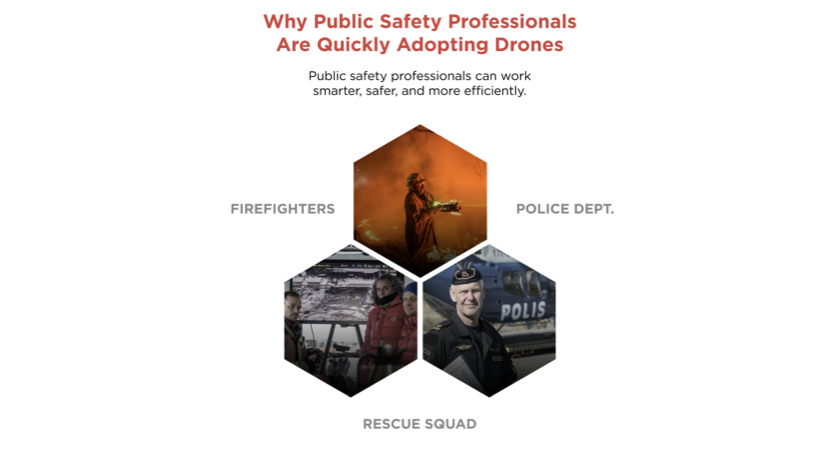
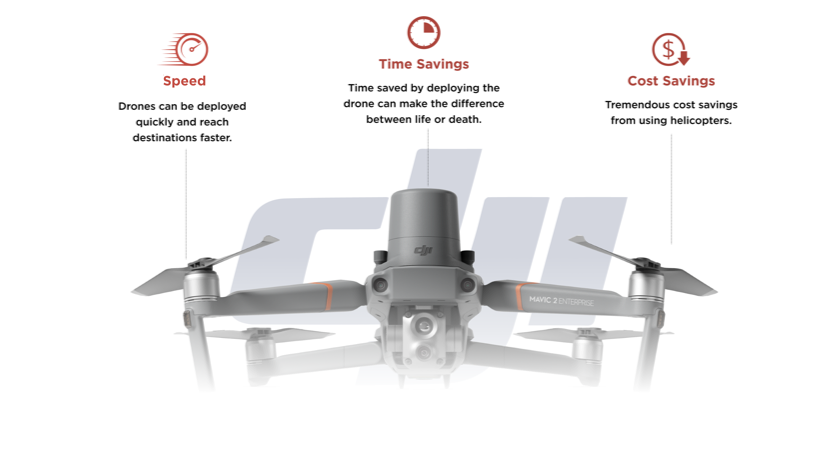
Public safety drones require a licensed pilot that can securely and safely operate in different areas and, sometimes, in complex situations (i.e. dark, low visibility, urban areas with lots of obstacles, bad weather, etc.). Also, depending on the situation and need, drones used for public safety can have different payloads such as thermal and night vision cameras, rescue kits, megaphones, etc.
Because of the seriousness of the situations in which these drones are used and the need for fast and efficient deployment, some local regulations could be relaxed so that law enforcement, firefighters, and other first responders can use them without acquiring special permits.
With that in mind, once the need for drone assistance arises, an agency or organization can deploy the drone from the designated area for drones (sometimes from the roof of the police or fire station) or wherever they need it. Drones can be deployed quicker than crewed aerial assistance and can reach destinations faster than ground teams.
In a rescue mission, where every second counts, time saved by deploying the drone can make the difference between life or death. Not only does that mean saving the life of a person in danger but also the lives of public safety professionals themselves. By using drones, public safety professionals can work smarter, safer, and more efficiently.
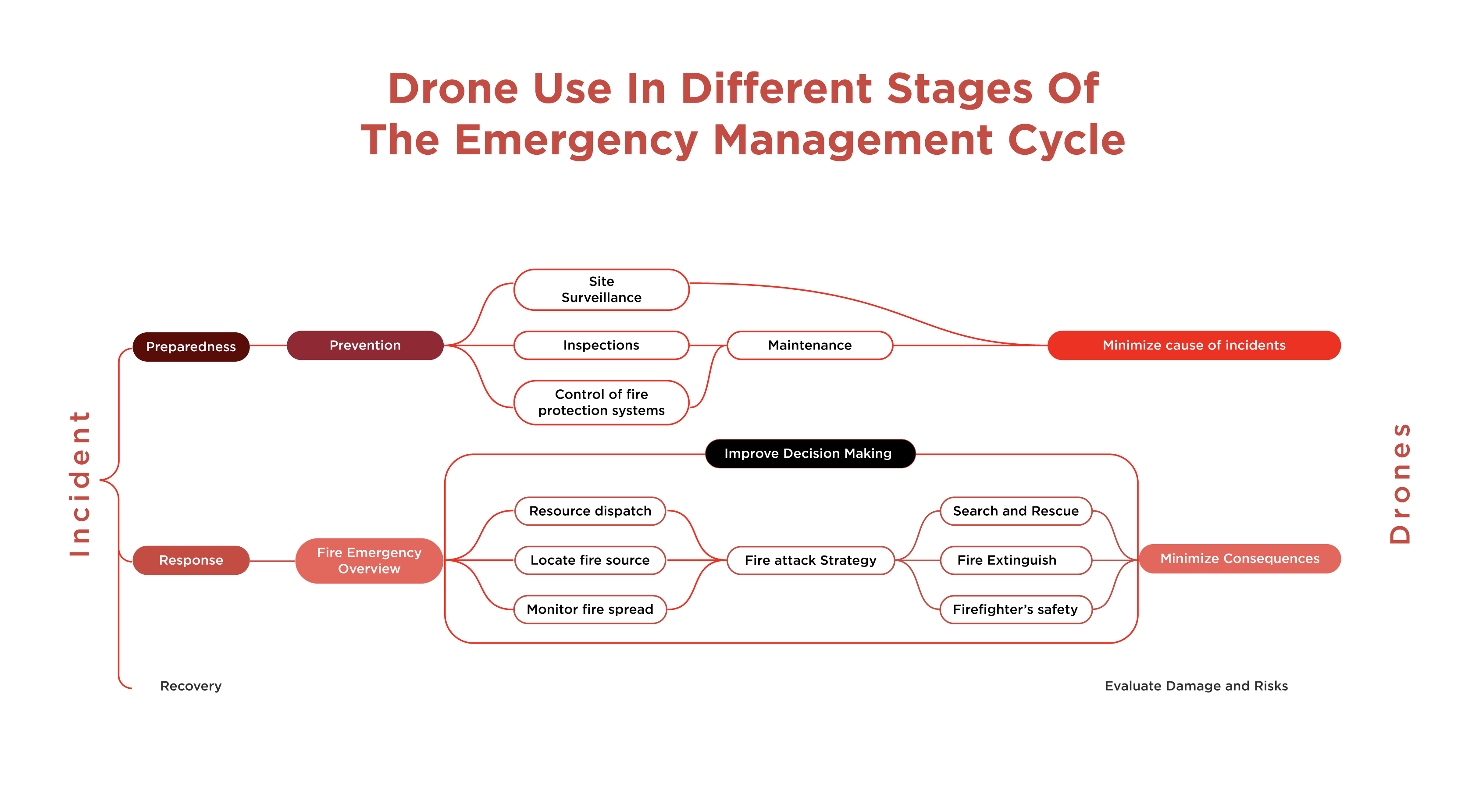
*Source : https://projekter.aau.dk/projekter/files/294663864/Master_Thesis__Vlad_Tiberiu_Radu__RISK4_11.pdf
Blog Outline
click to easily navigate through the page
How can drones be used to keep the public safe?
The use of drones in public safety has been rising in the last five years. Drones have become more readily available and public safety agencies are more prepared to try and use drones in their work to increase safety and efficiency. And those that have implemented drones are saving lives – to date, more than 600 lives all around the world have been saved thanks to the use of drones and first responders.
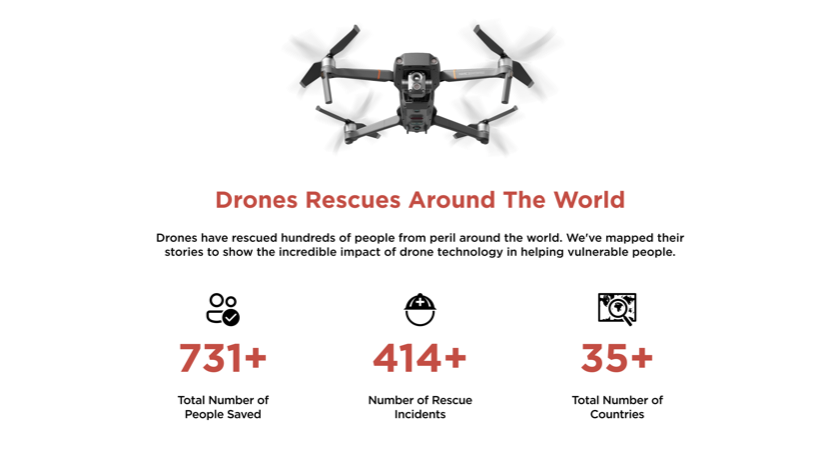
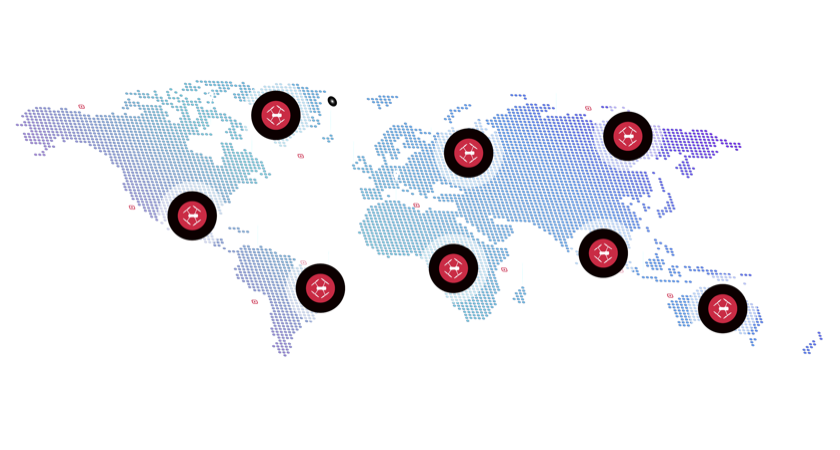
The importance of using drones in life-threatening situations can be seen on the DJI Drone Rescues Around the World, an interactive map that tells stories of how drones have helped rescue people from peril. There is not a region in the world where drones have not helped someone. From Earthquake Response in Croatia to helping save the life of an injured person that wandered away from the crash site in England, there are a vast number of incidents that were successfully resolved thanks to first responders and their use of drones.
Help others find out how #DronesHelp
More than 600 lives all around the world have been saved thanks to the use of drones. Every day there are more and more examples of drones helping to save lives.
If you know about a successful drone rescue, let us know. Report the rescue information by filling this form and help us share more of those great stories, and make sure every drone rescue gets the credit it deserves.
You can share your stories on social media with the hashtag #DronesHelp and to share more incredible stories where drones played an important part in helping someone. No matter how small you think the help was, for the person that was rescued, it meant a lot.
Police drones increase safety at just a fraction of the cost

One of the main reasons police use drones is their versatility and cost-effectiveness. The Swedish Police Authority has 9 helicopters and each hour of flight the department 3,000 €. In comparison, a compact, agile, and quickly deployable drone (such as the DJI Mavic 2 Enterprise series) decreases the cost of airborne response by 200% increasing their efficiency at a much lower cost to tax paying citizens. Police also use drones to better track dangerous criminals and locate evading suspects to arrest them before they can do more harm to the community.
On the other side, police in Great Britain have successfully used police drones
- in harsh windy and rainy conditions in search and rescue missions
- for locating a missing person
- for capturing 3D pictures of crime scenes and scenes of serious traffic accidents
Not only have public safety drones made their job easier and faster, they also are much more cost-effective than using helicopters or manpower.
Speed, ease of use, and cost-effectiveness are the main reasons drones are becoming a go-to tool for law enforcement professionals around the world.
Why are firefighting drones essential to firefighters on the ground
Law enforcement is not the only domain where drones can be used. Firefighters can deploy drones for situational awareness that can keep firefighters on the ground safe, finding hotspots or even fighting fire.
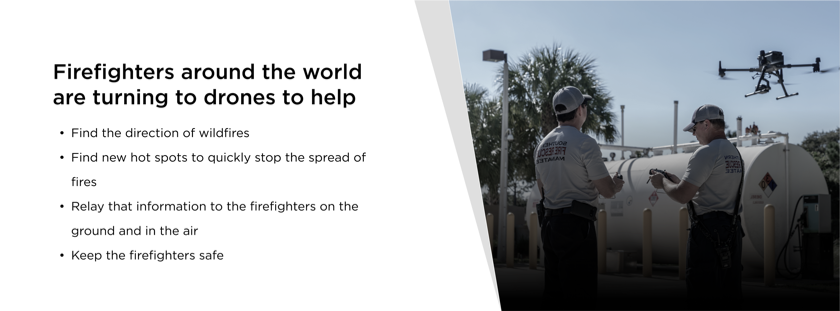
One of the examples is a case from 2020, when a large-scale wildfire broke out in the vicinity of the remains of the Chernobyl power plant. It lasted for days and took impressive firefighting power to get it under control.
Drones provided a critical vantage point from above, while visibility at ground level was almost zero. Drone operators forwarded gathered data to the ground team representatives who understood the situation and shared the important data via radio channels with the command centre and air and ground crews. All that translated into actionable intelligence that helped ground teams detect dangerous areas and put out the fire rapidly.
Drones were also an irreplaceable tool for French firefighters who were deployed to fight the Notre Dame fire. Firefighters on the ground used drones to track the progression of the fire and find the best positions to aim fire hoses.
With drone thermal cameras, Fire Commanders and Incident Safety Officers were able to detect areas where the building had potential to collapse. Seeing through the smoke they were able to spot areas of the roof that the fire was weakening, and were able to warn firefighters operating inside.
Although Parisian firefighters didn't have their own drones, they recognized the need for them and called the Parisian Police Drone Unit whose professional drone pilots flew the drones that were borrowed from France's culture and interior ministries. French firefighters showed how drones can be instrumental to intelligent firefighting, even if they didn't have their own firefighting drones on hand.
These are only some of many examples of using drones in firefighting.
From thermal cameras that can check where hot spots are or if the fire is contained, to giving firefighters and hazmat teams a bird’s eye view of a disaster area, drones are becoming invaluable tools in fighting a fire. They can check hard to reach places like tall or abandoned buildings, give a situation overview in dangerous situations in which lives could be at stake or would jeopardize firefighters, and even map the affected area. With the right payload they can even fight smaller fires.
Using drones in hazmat incidents
Hazmat incidents are among the most dangerous and most challenging for public safety professionals. They often involve (but are not limited to):
- multiple unknown variables
- dangerous, toxic, or volatile substances
- environmental threats (to people and responders)
- short time to respond safely.
To resolve such incidents firefighters and other public safety professionals use various tools to assess the situation and mitigate the incident. Drones can make a significant difference in such a situation.
With the use of the drones, they can:
- improve mitigation dramatically
- enhance safety (for responders and the public)
- reduce time (to resolve the situation).
Drones can provide remote reconnaissance and aerial monitoring, as well as identify hotspots and threats to people and property. With additional payloads, responders can identify injured persons, determine exposure issues, and determine the main problem - all while keeping a safe distance from the incident. Drones can also be used to safely overwatch and alert responders to changing or potentially dangerous conditions to raise real-time situational awareness.
Drones can also create maps of the area that can aid in post-incident damage assessments and clean-up planning.
Search and rescue drones save time - and lives
How drones can save lives is best seen when they are used in search and rescue. In search and rescue missions, every minute (and often every second) counts, especially when someone is missing or injured. That the person is found quickly, is even more critical during bad weather or low visibility conditions.
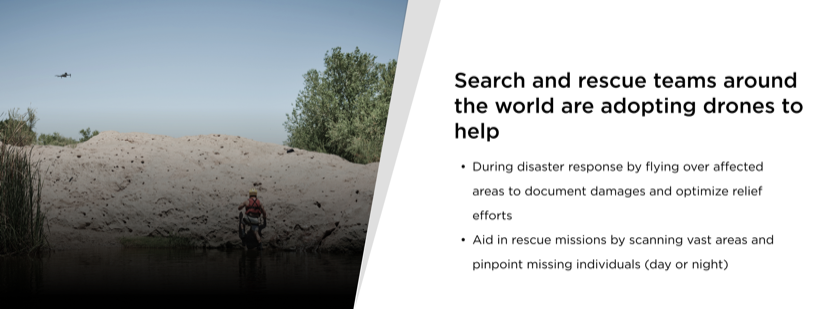
DJI conducted a study with EENA (European Emergency Number Association 112) to evaluate the impact of drones for locating lost persons in search and rescue events. 50 trials were conducted with SAR teams in Wicklow and Sligo (Ireland) and Wales (UK), where SAR professionals were distributed in 2 arms: drone-enabled teams and no-drone teams. The results of the trials have shown that when a team equipped with a drone finds the victim, they do it 3.18 minutes (191 seconds) faster than the no-drone team.
| Drone Arm | NoDrone Arm | NoDrone-Drone | |
| N (number of PAIRED events) | 19 | 19 | 19 |
| Mean (SD), in seconds | 1180 | 1371 | 191 |
On average, based on the experience of Croatian HGSS, a rescue mission using traditional tools takes about 30 minutes. If search and rescue drones are used, the time is reduced by at least 25%. That means a person can be found faster and without wasting resources.
Depending on the mission at hand, rescue drones can be deployed quickly and fly to scout the area with high-definition digital and thermal cameras, which is crucial in the search missions during the night.
|
TOOLS/EQUIPMENT |
AVERAGE RESPONSE TIME |
AVERAGE COST |
AREA COVERED IN 10 MINUTES |
|
Helicopter |
3h |
8.000€ per hour |
500 ha |
|
K9 Dogs |
1h |
100€ per hour |
2 ha |
|
Drones |
1h |
85€ per hour |
1-20 ha |
|
Ground Forces |
1h |
50€ per hour |
2 ha |
|
Balloon Gliders |
3h |
120€ per hour |
500 ha |
Table 3. Drones vs. Traditional SAR Tools / Equipment
How have drones saved lives?
Search and rescue teams can also use drones for
- scouting and mapping of potentially hazardous areas
- emergency response and post-disaster analysis, such as after hurricanes, floods, earthquakes, or other disasters.
- preparation for ski season on mountain slopes or climbing competitions on mountain cliffs and other potentially dangerous areas.
Drones were crucial tools during the biggest landslide disaster in Norwegian history.
- The landslide spanned two square kilometers, affecting the village of Ask in Gjerdrum. First responders had to fight time and temperatures as low as -23°C while locating survivors and helping them get to safety.
- When the rescue helicopters had airlifted the first survivors to safety, the drone operators launched DJI Matrice 300 RTKs to start mapping out the area, enabling the command center to coordinate the search from a safe distance.
- This became Europe’s largest drone rescue operation to date.

The drones deployed utilized the Zenmuse H20T thermal vision payload to create a high-resolution map in the dark. It took only one hour for the infrared images to be processed into a finished 3D map after the drones landed. The map was then made accessible to all emergency services involved in the mission, giving them the information they needed to safely navigate the disaster site in the dark.
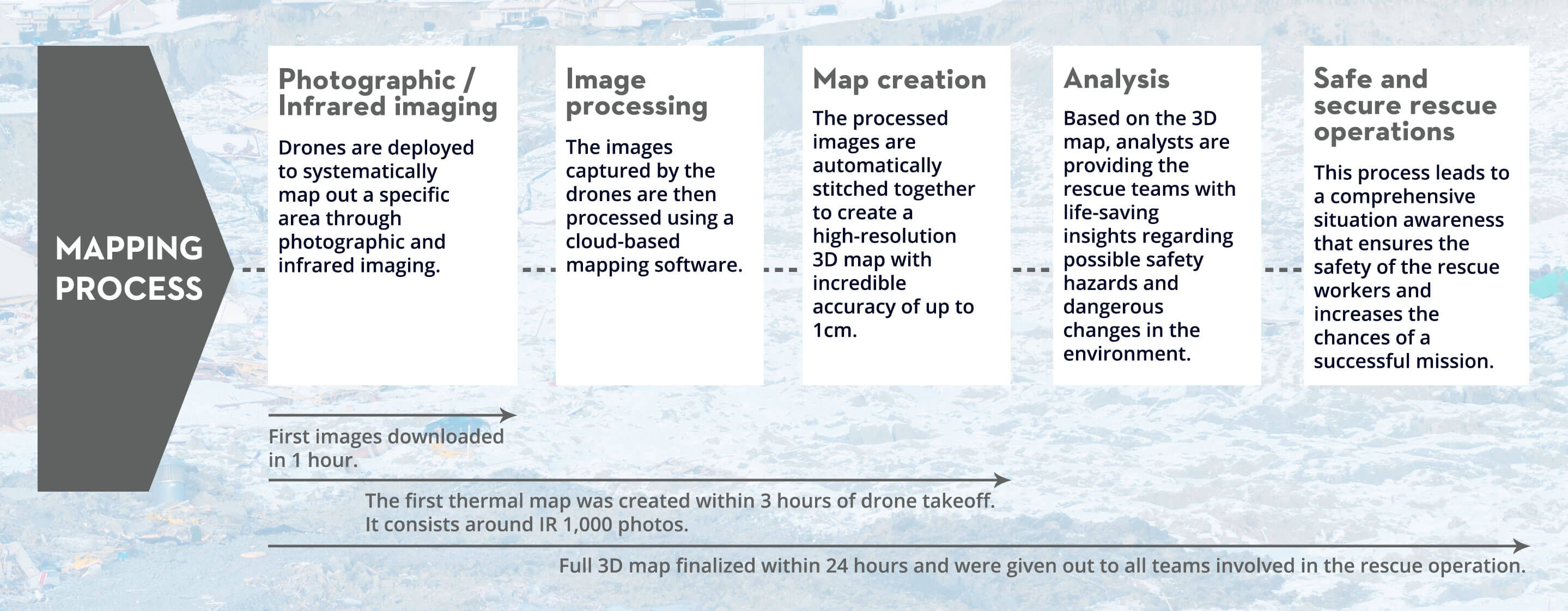
The 3D model map of the area, finalized within the first 24 hours, proved to be a critical source of information as it provided comprehensive situational awareness to ensure a safe and secure rescue operation.
|
Before drones |
After drones |
|
Wait for satellite imagery ● Low resolution ● Out-of-date ● Static images
|
3D model map finalized within first 24 hours ● High-resolution ● Up-to-date ● Precise |
In the end, drones helped rescue 13 people and even saved a dog that was trapped for 22 hours.
Using unmanned DJI drones allowed Norwegian first responders to push the limits of the operation and do things previously unthought of, such as using drones as makeshift battering rams to break windows through which a second drone could fly in. Even though DJI drones are not generally supposed to be used in this way, they highlight the true benefit of drones for rescue operations: the ability to do whatever it takes to save lives without risking the health and safety of the rescue team.
The use of drones in medical emergencies
In addition to helping first responders like police officers and firefighters, drones can also be helpful even in serious medical emergencies like the case of a blood delivery that saved a 2-year-old girl in Rwanda.
There are already pilot programs carried out around the world where drones are making medicine deliveries to remote and hard to reach areas.
Using drones to deliver medical supplies and personal protective equipment (PPE), or to carry medical samples from the collection center to the testing facility, can not only exponentially reduce transportation times, but can also decrease the chance of secondary pollution from human contact. Amidst the COVID-19 pandemic, “no-contact delivery” of medical test kits and vaccines can be done via an autonomous drone delivery network equipped with an additional payload such as special containers that can be heated or cooled to a specific temperature. This ensures that the payload will not be tampered with and that it will arrive at its destination in just a fraction of time it would take to arrive through the conventional means of transportation.
Even a drone equipped with a megaphone can help save lives if it gives out instructions on how to perform first aid to someone and hovers over an injured person so that medical professionals can find them more easily.
Summary - Drones for Police, Firefighting, and Search and Rescue
Where to start and how to build a drone program?
Using a drone in public safety has never been more vital. Whether deployed to gather data and information so that professionals can make informed decisions, or to save lives and property, drones are invaluable in helping keep the public safe and sound.
But starting a drone program in a publicly funded agency can be a challenging endeavor. That is why DJI has prepared a guidebook that highlights what needs to be done and ways to execute it. It can help you overcome challenges with starting a drone program in your agency.
You can request the Building a Drone Program guidebook by filling in the form and reading about experiences and success stories from law enforcement agencies that have successfully started their own drone programs and collaboration networks.
Click here to read more on how to start or scale your drone program and join us in creating a safer future.








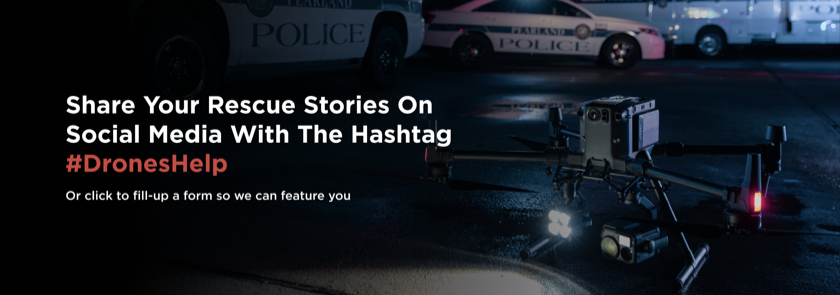
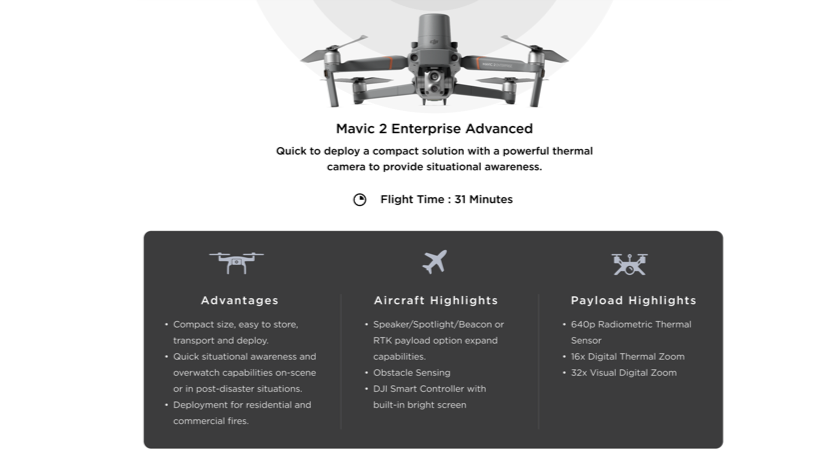

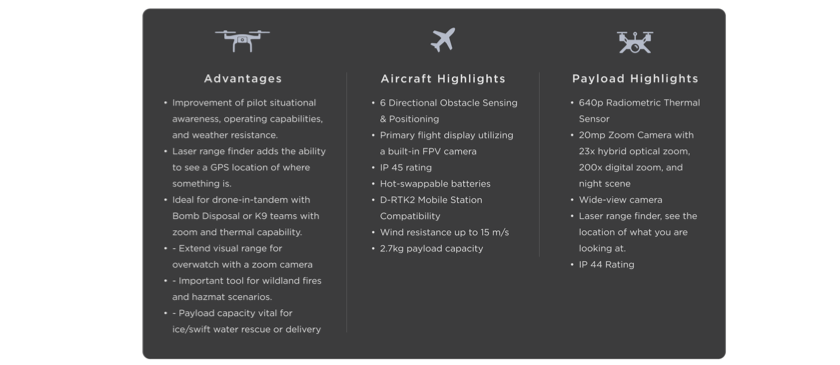


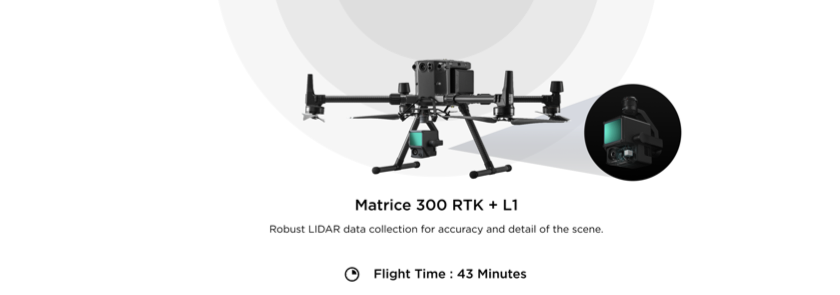

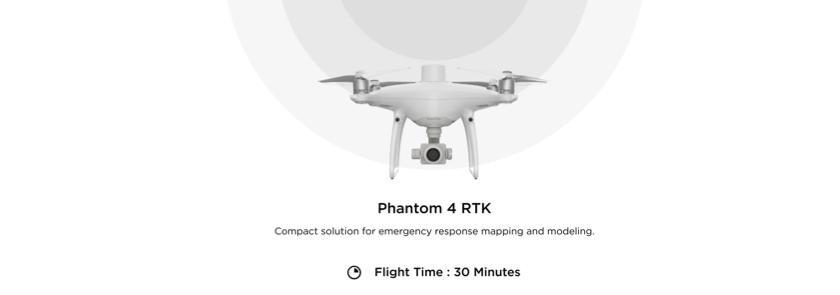


.png?width=300&name=L3kv%20(1).png)

.png?width=300&name=FH2%20update%20(1).png)
-1.png?width=300&name=HS%20-%20Featured%20Images%20(3)-1.png)